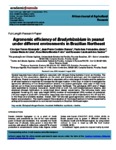Use este identificador para citar ou linkar para este item:
http://www.alice.cnptia.embrapa.br/alice/handle/doc/1052954Registro completo de metadados
| Campo DC | Valor | Idioma |
|---|---|---|
| dc.contributor.author | SIZENANDO, C. I. T. | pt_BR |
| dc.contributor.author | RAMOS, J. P. C. | pt_BR |
| dc.contributor.author | FERNANDES JUNIOR, P. I. | pt_BR |
| dc.contributor.author | LIMA, L. M. de | pt_BR |
| dc.contributor.author | FREIRE, R. M. M. | pt_BR |
| dc.contributor.author | SANTOS, R. C. dos | pt_BR |
| dc.date.accessioned | 2016-09-16T11:11:11Z | pt_BR |
| dc.date.available | 2016-09-16T11:11:11Z | pt_BR |
| dc.date.created | 2016-09-16 | pt_BR |
| dc.date.issued | 2016 | pt_BR |
| dc.identifier.citation | African Journal of Agricultural Research, v. 11, n. 37, p. 3482-3487, sept. 2016. | pt_BR |
| dc.identifier.uri | http://www.alice.cnptia.embrapa.br/alice/handle/doc/1052954 | pt_BR |
| dc.description | Several legumes have natural ability to associate with nitrogen - fixing bacteria known as rhizobia. The efficiency of this association depends on the plant and bacterial genotype and the edaphoclimatic conditions. Peanut is a tropical legume able to associate with a wide range of rhizobia and the selection of efficient bacteria is important to increase the nitrogen fixation in this crop. In order to investigate the agronomic efficiency of two Bradyrhizobiumstrains, two peanut genotypes were used in field trails carried out in three environments located at Brazilian Northeast. The genotypes (BR1 and L7 Bege) were submitted to rhizobial inoculation (SEMIA 6144 or ESA 123, both Bradyrhizobium strains, and chemical nitrogen fertilization in randomized block design experiments. The following traits were analyzed: flowering (F), main axis height (MAH), number of nodules/plant (NN), number of pods/plant (NP) and weight of pods (WP). Differential responses were found in all to treatments to NN, NP and WP, in the three environments studied. Overall, ESA 123 showed good agronomic performance inducing higher pod production. The results supportthe evaluation of the Bradyrhizobium in further experiments aiming at its recommendation to commercial inoculants in Brazilian Northeast region. | pt_BR |
| dc.language.iso | eng | eng |
| dc.rights | openAccess | eng |
| dc.subject | Fixação biológica de nitrogênio | pt_BR |
| dc.subject | Fertilização | pt_BR |
| dc.subject | Rizóbios | pt_BR |
| dc.subject | Biological nitrogen fixation | pt_BR |
| dc.subject | Inoculant | pt_BR |
| dc.subject | Peanut | pt_BR |
| dc.title | Agronomic efficiency of Bradyrhizobium in peanut under different environments in Brazilian Northeast. | pt_BR |
| dc.type | Artigo de periódico | pt_BR |
| dc.date.updated | 2016-09-16T11:11:11Z | pt_BR |
| dc.subject.thesagro | Amendoim | pt_BR |
| dc.subject.thesagro | Bacteria | pt_BR |
| dc.subject.thesagro | Leguminosa | pt_BR |
| dc.subject.thesagro | Inoculante | pt_BR |
| dc.subject.thesagro | Simbiose | pt_BR |
| dc.subject.nalthesaurus | Symbiosis | pt_BR |
| dc.subject.nalthesaurus | Bradyrhizobium | pt_BR |
| riaa.ainfo.id | 1052954 | pt_BR |
| riaa.ainfo.lastupdate | 2016-09-16 | pt_BR |
| dc.identifier.doi | 10.5897/AJAR2016.11294 | pt_BR |
| dc.contributor.institution | CIRO IGOR TORRES SIZENANDO, Universidade Estadual da Paraíba; JEAN PIERRE CORDEIRO RAMOS, Universidad e Federal da Paraíba; PAULO IVAN FERNANDES JUNIOR, CPATSA; LIZIANE MARIA DE LIMA, CNPA; ROSA MARIA MENDES FREIRE, CNPA; ROSEANE CAVALCANTI DOS SANTOS, CNPA. | pt_BR |
| Aparece nas coleções: | Artigo em periódico indexado (CPATSA)  | |
Arquivos associados a este item:
| Arquivo | Descrição | Tamanho | Formato | |
|---|---|---|---|---|
| PauloIvan2016.pdf | 256,66 kB | Adobe PDF |  Visualizar/Abrir |









